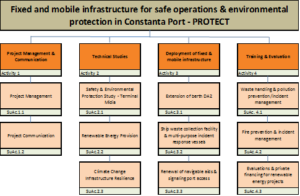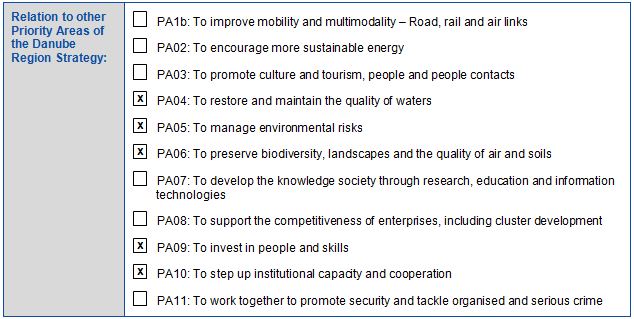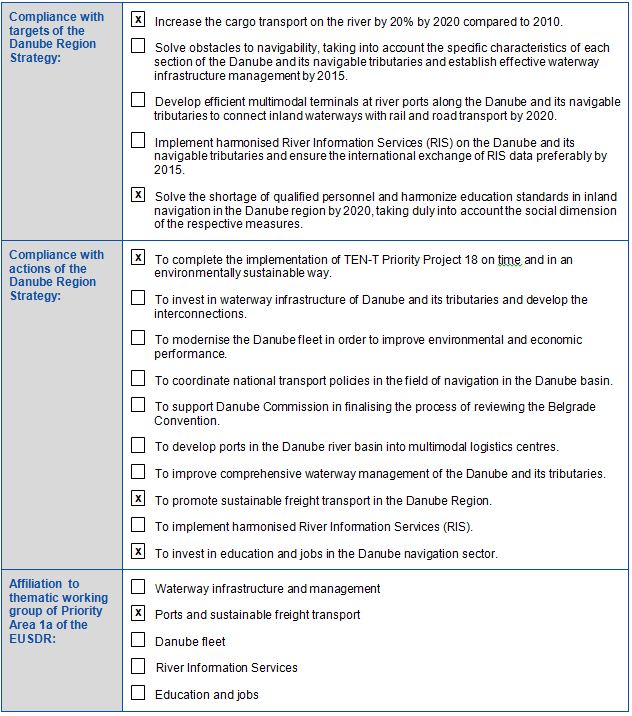BASIC PROJECT DATA
Project ID: PA1A117
Project website: https://www.portofconstantza.com/pn/page/np_programe_strategii
NEED AND ADDED VALUE FOR THE DANUBE REGION STRATEGY
Constanta Port plays a special role in connecting the maritime & the inland transport. The development plans for Constanta Port therefore take into account the requirements established for seaports as well as those for inland ports. Constanta’s position at the eastern gateway of the EU has a vital role in distributing freight throughout the continent, linking Central and South-Eastern Europe to the Black Sea, Middle East and Central Asia. Its position and the high amount of vessels (14.370 in 2015) and freight (56.3 million tons in 2015) also make it susceptible to a lot of environmental risks and accidents that are usually associated to port activities.
Although the port administration has a defined set of procedures in place in regards to providing ship waste collection services within its jurisdiction area, the available equipment is obsolete as compared to the requests submitted by the port users. The vessels now used to provide ship waste collection services date back to 1963 and have already undergone 5 reclassification cycles. The maintenance costs associated to such a fleet are considerable and taking into account the long service periods required for the vessels, it is becoming increasingly difficult to comply with the provisions of the international regulations Romania is a party to. In line with the Romanian legislation, the port administration is also required to provide assistance when putting out fires, to depollute the port waters, to collect oily and greasy ship waste and other residues.
In addition to this, due to the high traffic volume registered so far and to the favourable geographical position of Constanta, extensions of the breakwaters have been made in order to enlarge this transport hub. The increased port area also implies the need for modern vessels capable of providing high quality services in a reduced time interval. More vessels also necessitate an adequate place to be moored and a corresponding on-shore waste collection facility to properly store and treat the collected amounts of residues.
Furthermore, the above mentioned extension of the northern breakwater also triggers the need for the reconfiguration of the port’s signalling system to ensure safe access and prevent any sort of accidents that might result in oil spills or other sort of pollution incidents.
OBJECTIVE(S) OF THE PROJECT
Taking into consideration the current needs of Constanta Port, the project will focus on safe maritime port access in the form of navigational aids (upgrading the signalling system in the port basin and the fairway), extension of basic infrastructure in the form of quays, constructing a new state of the art on-shore waste collection and treatment facility, and purchasing a technical vessel. The overall objective is to tackle environmental tasks that will bring Constanta Port at the same foot with other ports of similar size.
PLANNED PROJECT ACTIVITIES
It is a mixed project including both studies and works.
The studies in the project consist of feasibility studies and detailed technical designs and concepts to achieve a high level of safety and environmental protection for the operations in Constanta Port. The main focus will be:
- Elaborating the feasibility studies and the detailed technical designs for the infrastructure and superstructure associated with an on-shore waste collection facility in Midia Port. This satellite port located 13,5 NM North of Constanta is operating oil products and other derived products, LPG and metal products. At this moment, there are no waste collection facilities or specialized vessels capable to intervene in this location, should accidents occur.
- The possibility of using renewable energy sources in the port area will also be investigated in the project:
- detailed technical designs for a photovoltaic power station will be made
- a feasibility study as well as the accompanying geotechnical studies will be made for a wind power station
- the revision of an existing feasibility study and the elaboration of the accompanying technical designs for the modernization of the energy distribution network will be made
- Investigations will also be conducted in connection to the climate change infrastructure resilience measures that should be adopted for Constanta Port
The works in the project include:
- Extension with 130 linear meters of the DA 2 berth in Constanta Port in order to create a platform covering 4370 sq. m that would be used for the construction of an on-shore ship waste collection facility
- Building the on-shore ship waste collection facility
- Purchase of one vessel used to perform different tasks within Constanta Port:
1 multi-functional vessel used for fighting fires on vessels and port superstructures, for installing buoys and for towing different equipment within the port area - Updating the signalisation system in Constanta Port required by the extension of the North Breakwater and the obsolete state of some of the elements used:
- Installing 3 seamarks along the north and south breakwaters
- Building a white signalling pole on the direction CS-KW in order to buoy the area around mole 3 which is still under construction
- Installing AIS on buoy C-KS so that together with the other equipment available it can mark the landing area of Constanta port on the vessels’ radar systems
- Building 2 signalling poles on the extremities of the breakwaters in Constanta South Port (green and red) in order to facilitate the entry into Agigea port at night time
- Replacing the following signalling poles: CS-SR2, CS-SR4, CS-SG-1 (installed in the time interval 2000-2002) that are no longer compliant with IALA regulations
- Replacing C-X1 buoy, a GBN-240-type of buoy with a A8L buoy (including swamped mooring)
- Provide an additional solar panel and an electrical battery to support the signalling system in Constanta Port
- Reconfiguration of the coordinates for the following buoys: C-KS, C-KE, C-KW after the seamarks are installed on the extremities of the south and north breakwaters
- Creating a supply for the signalling system in Constanta Port consisting of spare parts in case of emergency situations:
- Green A8L buoy – 2 pieces
- Red A8L buoy – 2 pieces
- KS buoy – 1 piece
- KE buoy – 1 piece
- KW buoy – 1 piece
- GBM 3000 buoy – 1 piece
- Green 1800 buoy – 1 piece
- Red 1800 buoy – 1 piece
In addition to this, a special activity will be dedicated to the training needs of the port administration staff members. The possibility of attracting private investors to deal with renewable energy projects will also be analysed within this activity.
The proposed Action is included in the list of pre-identified sections and projects stipulated in Annex I, Part I.2 of the CEF Regulation and is thus eligible for funding under the above mentioned CEF priority.
The project shall be divided into 4 activities:
- Activity 1: Project Management
- Activity 2: Technical Studies
- Activity 3: Deployment of Fixed & Mobile Infrastructure
- Activity 4: Training and Evaluation
Activity 1 will include all the project management tasks needed for the successful implementation and completion of the project. Dissemination activities are also foreseen in line with the requirements of the funding program.
Activity 2 will deliver the studies elaborated at project level. These will be focused on three topics. The preparations needed for the creation of proper ship waste collection facilities in Midia Port will be addressed in a distinct sub-activity (1). Possibilities for the provision and distribution of renewable energy in the port of Constanta will also be treated. Special focus will be targeted on photovoltaic panels and a wind power station, as well as on the upgrade of the energy distribution network within the port (2). Climate change infrastructure resilience measures will also be analysed in connection to the existing port infrastructure and the currently available port development plans. (3)
Activity 3 consists in the works performed within the project. A 130-meter-berth extension is planned to provide the basis for the construction of an on-shore ship waste collection facility. One vessel will be purchased to reinforce the fleet the port administration now uses to provide ship waste collection and fire-fighting services. The signalling system within the port will also be upgraded to correspond to the recent infrastructure extensions of the port and to the IALA regulations.
Activity 4 will deliver the training classes needed by the employees of the port administration in order to properly use and exploit the newly purchased equipment and the ship waste collection facility. Furthermore, investigations will be made to assess the potential that the port renewable energy projects have to attract private investors and generate public private partnerships.
TRANSBOUNDARY IMPACT
Constanta Port is 85nM from the Danube’s mouth by the sea and is also linked to it by the Black-Sea-Danube Canal, thus interacting with the Danube ports and the Black-Sea ports as well. A high quality of the ship waste collection services in the Port will limit the risk of pollution and oil spills that might affect the Black Sea Region and pose a threat to the environment and the population.
High quality port services provided efficiently by the port administration will also attract more responsible business partners to the area.
PROJECT BENEFICIARIES / TARGET GROUPS
- Shipping companies
- Port operators
- Port tenants
- Forwarding companies
- Port administrations in the Danube and Black Sea Region
STATUS AND TIMEFRAME
Start date: 01.07.2016
End date: 30.05.2023
This project was prolongued from 2019 to 2023.
FINANCING
Total budget: 12,696,125 EUR
EU funds: 10,791,706 EUR are funded by Connecting Europe Facility (CEF) 2014 – 2020
National funds: 1,904,419 EUR
PROJECT TEAM
Project leader: National Company Maritime Ports Administration SA Constanta
(website: www.portofconstantza.com)
Address: Incinta Port, Gara Maritima, 900900 Constanta / Romania
There are no additional partners involved.
PROJECT ENVIRONMENT
PROJECT CROSS – REFERENCE
The proposed action takes into account the plans included in the following projects that are or were promoted for implementation by Constanta Port Administration:
- Completion of the Northern Breakwater of Constantza Port – extension by 1,050m (PA1A055)
- Road Bridge at km 0+540 of the Danube-Black Sea Canal (PA1A057)
- Development of the railway capacity in the river-maritime area of Constanta Port (PA1A056)
- Extension to the south of the barge wharf
- Constanta Sud Port. Bridge over the connection canal in the fluvial and maritime area and connections to the internal and external roads network of the port
- Pier IIIS- Pier IVS infrastructure development
- Project “Green Port Constanta”, CEF Call 2015 grant application
STRATEGIC REFERENCE
The project addresses key priorities of the European Union transport policy such as:
- Europe 2020, strategy for smart, sustainable and inclusive growth: to comply with reducing greenhouse gas emissions by 20% (or even 30%, if the conditions are right) lower than 1990, reduce energy consumption by 20% through increased energy efficiency, to meet 20% of energy needs from renewable sources
- The White Paper on Transport – 2030/2050 perspective (2010) & Single Market Act II: emphasize the need for well-connected port infrastructure, efficient and reliable port services and transparent port funding
- A roadmap to moving to a competitive carbon economy in 2050 (2011): the EU should prepare for reductions in its domestic emissions by 80% by 2050 compared to 1990
- Ports: an engine for growth COM (2013) 295 final: setting up the EU strategy needed to help ports implement good practices and sound managerial approaches while fully respecting diversity and particular circumstances
- The REFIT Revision ofEU Directive 2000/59/EC on port reception facilities for ship-generated waste and cargo residues: improving the availability and use of facilities in ports for receiving waste from ships
- The Clean Power Transport Directive which requires liquefied natural gas (LNG) refuelling points and shore side electricity (unless not economically viable) in all core ports by 2025
RELEVANT LEGISLATION
- The Romanian Master Plan for Transport for the short, medium and long term perspective: which analyses the transport priorities at national level and reviews the measures that need to be adopted in order to increase the traffic volume and shift considerable volumes of freight to less polluting transport modes
- The 2008 Constanta Regional Development Plan currently in force
- The Master Plan for the Port of Constanta and its accompanying Development Strategy on short medium and long term which highlights the most critical aspects regarding the future development of this port, among which are strategizing and organizational planning while also considering environmental issues
EUSDR EMBEDDING
EUSDR COMPLIANCE
META DATA
Data provided by: Mihaela Staetu (National Company Maritime Ports Administration SA Constanta, Romania) – 29.01.2016
Last update by: viadonau, Austria – 12.10.2017
Download pdf




